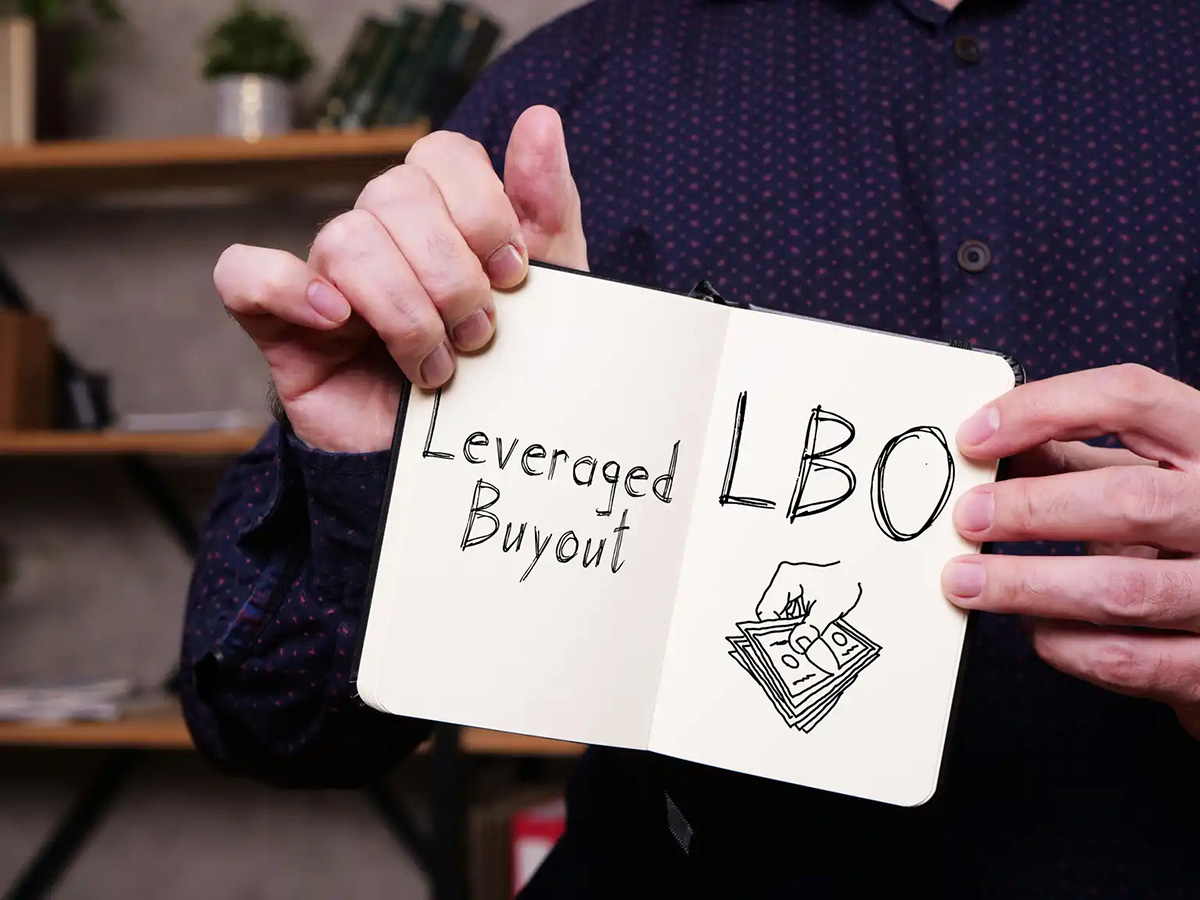

Finance
How Do Leveraged Buyouts Work
Modified: December 30, 2023
Discover the inner workings of leveraged buyouts in the field of finance. Learn how financial leverage is used to acquire controlling interests in companies.
(Many of the links in this article redirect to a specific reviewed product. Your purchase of these products through affiliate links helps to generate commission for LiveWell, at no extra cost. Learn more)
Table of Contents
Introduction
Welcome to our comprehensive guide on leveraged buyouts. In the world of finance, leveraged buyouts (LBOs) are a strategic transaction that allows investors to acquire a company by utilizing a significant amount of debt. This financial maneuver can provide immense opportunities for both the acquiring company and its new owners, but it also carries inherent risks.
In this article, we will delve into the intricacies of leveraged buyouts, exploring the steps involved, the considerations when assessing a target company, the process of securing financing, negotiating the deal, and closing the transaction. We will also discuss the transition to the new ownership structure and the benefits and risks associated with this type of transaction.
Leveraged buyouts have a fascinating history and have been employed in various industries over the years to reshape and revitalize companies. By understanding the inner workings of leveraged buyouts, you can gain valuable insights into how these transactions work and the potential opportunities they offer for investors and businesses alike.
So, whether you are an aspiring investor, a business owner exploring options for expanding your enterprise, or simply intrigued by the world of finance, this guide will provide you with a comprehensive overview of leveraged buyouts and the key factors involved.
Definition of Leveraged Buyouts
A leveraged buyout (LBO) refers to a financial transaction in which a company or a group of investors acquires another company by using a significant amount of borrowed money. The acquiring company typically uses the assets and cash flow of the target company, as well as additional debt financing, to fund the purchase.
Leveraged buyouts are often characterized by the high level of debt that is used to finance the transaction. The acquired company’s assets and future cash flows serve as collateral for the borrowed funds, thereby allowing the acquiring company to leverage these assets and generate returns on investment.
One of the key aspects of a leveraged buyout is the structure of the financing. Typically, the acquiring company, also known as the “sponsor,” contributes a relatively small amount of equity capital, while the majority of the purchase price is funded through debt. This debt can come from various sources, such as bank loans, bonds, or other forms of financing.
The primary objective of a leveraged buyout is to create value for the acquiring company and its investors through a combination of financial restructuring, cost-cutting measures, operational improvements, and potential exit strategies. By taking a company private through an LBO, the acquiring company gains greater control and flexibility to implement these strategic initiatives and drive profitability.
It is important to note that leveraged buyouts are not without risks. The high level of debt used in the transaction exposes the acquiring company to potential financial distress, especially if the target company’s performance declines or the market conditions change unfavorably. Additionally, the success of a leveraged buyout depends on the ability of the acquiring company to execute its strategic plans and generate the expected returns.
In the next sections, we will explore the various steps involved in a leveraged buyout, the factors to consider when assessing a target company, and the financing options available to support the transaction.
Steps of a Leveraged Buyout
A leveraged buyout (LBO) involves a series of well-defined steps that need to be followed in order to successfully acquire a target company. These steps typically include assessing the target company, securing financing, negotiating the deal, closing the transaction, and transitioning to the new ownership structure.
Let’s take a closer look at each of these steps:
- Assessing the Target Company: Before initiating an LBO, the acquiring company conducts thorough due diligence on the target company. This involves analyzing its financial statements, growth prospects, market position, potential synergies, and any potential risks or liabilities. This assessment helps the acquiring company determine the valuation of the target company and the feasibility of the transaction.
- Securing Financing: Once the target company has been assessed and a purchase price has been agreed upon, the acquiring company needs to secure the necessary financing for the LBO. This involves identifying potential lenders, negotiating financing terms, and structuring the debt and equity components of the transaction. The acquiring company may secure financing from banks, private equity firms, or other institutional investors.
- Negotiating the Deal: With financing in place, the next step is to negotiate the terms of the LBO with the target company’s shareholders or representatives. This includes discussing the purchase price, the amount of debt assumption, the treatment of existing management, and any other key terms and conditions. Negotiations may involve multiple rounds of discussions and may be facilitated by investment bankers or financial advisors.
- Closing the Transaction: Once the terms of the LBO have been agreed upon, the transaction enters the closing phase. This involves finalizing legal documents, conducting any necessary regulatory filings or approvals, and completing the transfer of ownership from the target company’s shareholders to the acquiring company or its designated entity. The closing process typically requires coordination among legal teams, financial advisors, and other parties involved in the transaction.
- Transitioning to the New Ownership Structure: After the LBO is successfully closed, the acquiring company begins the process of transitioning the target company to its new ownership structure. This may involve implementing strategic initiatives, restructuring operations, optimizing cost structures, and aligning the target company’s management with the acquiring company’s vision and goals. The objective is to maximize the value of the acquired company and generate returns on investment.
By following these steps, the acquiring company can execute a successful leveraged buyout and capitalize on the potential opportunities offered by acquiring and reshaping a target company. However, it’s essential to note that each LBO is unique and may have specific nuances and considerations based on the industry, size of the transaction, and other factors.
Assessing the Target Company
When considering a leveraged buyout (LBO) transaction, one of the crucial steps is to thoroughly assess the target company. This process, known as due diligence, involves conducting a comprehensive evaluation of the target company’s financials, operations, market position, and potential risks and opportunities.
Here are some key factors to consider when assessing the target company:
- Financials: Start by examining the target company’s financial statements, including its balance sheet, income statement, and cash flow statement. Analyze the company’s revenue growth, profitability, and cash flow generation. Assess its key financial ratios, such as debt-to-equity ratio and return on investment, to gauge its financial health and stability. Understand the company’s historical and projected financial performance to assess its growth potential and ability to service the debt incurred in the LBO.
- Market Position: Evaluate the target company’s competitive landscape and market position. Assess its market share, customer base, and the strength of its brand. Understand the industry dynamics, trends, and potential threats or opportunities that may impact the target company’s future prospects. Consider the competitive advantages and barriers to entry that the company possesses, such as intellectual property, proprietary technology, or strategic partnerships.
- Operations and Management: Gain insights into the target company’s operations, including its production processes, supply chain, and distribution channels. Assess the quality and depth of its management team, their experience, and their ability to execute the company’s strategic objectives. Evaluate the company’s research and development capabilities, innovation track record, and the scalability of its operations. Identifying potential operational efficiencies and synergies post-acquisition can enhance the value creation potential of the LBO.
- Risks and Liabilities: Conduct a thorough examination of the target company’s potential risks and liabilities. This includes legal and regulatory compliance, litigation history, environmental liabilities, and potential contingent liabilities. Assess any pending lawsuits, regulatory investigations, or potential damage to the company’s reputation. Understanding these risks will help mitigate potential drawbacks and ensure a more accurate valuation of the target company.
- Synergies and Growth Opportunities: Identify potential synergies between the acquiring company and the target company. This may involve evaluating how the combined entities can benefit from cost savings, increased market share, cross-selling opportunities, or shared resources. Assess the target company’s growth prospects, including its ability to expand into new markets, launch new products, or leverage emerging trends. This analysis will determine the potential upside and long-term value creation potential of the LBO.
By conducting a comprehensive assessment of the target company, the acquiring company can make informed decisions regarding the LBO transaction. This analysis helps to determine the appropriate valuation, negotiate favorable terms, and create a strategic plan for maximizing the value and potential of the acquired company.
Securing Financing
Securing financing is a critical step in executing a leveraged buyout (LBO) transaction. The acquiring company must identify and secure the necessary funds to finance the purchase of the target company. The financing structure for an LBO typically involves a combination of debt and equity.
Here are the key considerations when securing financing for an LBO:
- Evaluation of Financial Needs: The acquiring company needs to determine the total amount of financing required for the LBO. This includes the purchase price of the target company, transaction fees, working capital needs, and any additional capital for growth initiatives or post-acquisition operational improvements. A detailed financial analysis and projections are essential in assessing the financing needs accurately.
- Debt Financing: Debt financing is a fundamental component of an LBO. The acquiring company typically raises a significant amount of debt to fund the acquisition. This debt can be sourced from various lenders, such as commercial banks, institutional investors, or specialized debt providers. The terms of the debt, including interest rates, repayment schedule, and covenants, are negotiated in this stage.
- Equity Financing: While debt financing forms the majority of the funding for an LBO, equity also plays a crucial role. The acquiring company, along with its investors, contributes equity capital to the transaction. This can come from the acquiring company’s existing shareholders, private equity firms, or other institutional investors. The equity financing provides a cushion and helps cover a portion of the purchase price, reducing the reliance on debt.
- Structuring the Financing: The acquiring company needs to assess the optimal structure for the financing. This involves determining the appropriate mix of debt and equity, evaluating various financing options, and negotiating the terms and conditions with potential lenders and investors. The financing structure should strike a balance between meeting the funding needs of the LBO while ensuring the financial stability and sustainability of the acquiring company post-acquisition.
- Due Diligence by Lenders and Investors: Lenders and investors will also conduct their own due diligence on the acquiring company and the target company. They will assess the financials, industry outlook, management team, and the overall viability of the LBO. This due diligence is necessary for lenders and investors to evaluate the risk-return profile of their investment and determine the appropriate terms and conditions for the financing.
- Negotiating and Finalizing Financing Terms: Once potential lenders and investors have expressed interest in financing the LBO, the acquiring company will enter into negotiations to finalize the financing terms. This may involve discussions on interest rates, repayment schedules, collateral requirements, and other covenants. The objective is to secure the most favorable financing terms that align with the acquiring company’s financial capabilities and objectives.
Securing financing is a critical aspect of a successful LBO. The acquiring company must ensure that it has sufficient funds to complete the acquisition, while also considering the impact of the debt on its financial standing and ability to generate returns. By effectively navigating the financing process, the acquiring company can move closer to executing the leveraged buyout and realizing the value creation potential of the transaction.
Negotiating the Deal
The negotiation phase is a critical step in the process of executing a leveraged buyout (LBO). This is where the acquiring company and the target company’s shareholders or representatives come together to discuss and agree upon the terms and conditions of the transaction. Successful negotiations result in a mutually beneficial deal that satisfies both parties.
Here are the key elements involved in negotiating the deal for an LBO:
- Purchase Price: The purchase price is a crucial aspect of any LBO negotiation. The acquiring company and the target company’s shareholders need to agree on a fair valuation for the company being acquired. This valuation takes into account various factors, such as the financial performance, growth prospects, market position, and potential synergies of the target company.
- Debt Assumption: In an LBO, the acquiring company often assumes a portion of the target company’s existing debt. During negotiations, the acquiring company and the target company’s shareholders determine the amount of debt that will be transferred as part of the transaction. The acquiring company evaluates the impact of this debt on its financial position and considers the terms and conditions associated with the assumed debt.
- Management and Employee Retention: The negotiation phase also involves discussions about the retention of management and key employees of the target company. The acquiring company may want to retain the existing talent to ensure a smooth transition and capitalize on their knowledge and expertise. Negotiations may include provisions for management equity ownership, performance incentives, and employment agreements.
- Contingencies and Closing Conditions: As part of the negotiation process, contingencies and closing conditions are established. These are criteria that need to be met for the transaction to be completed. These conditions could include obtaining regulatory approvals, securing financing, or reaching certain performance targets. Negotiating these conditions helps ensure the acquiring company and the target company’s shareholders agree on the necessary steps to finalize the deal.
- Non-Disclosure and Confidentiality: During negotiations, both parties may enter into non-disclosure agreements and confidentiality agreements to protect sensitive information shared during the due diligence process. These agreements outline restrictions on the use and disclosure of confidential information and establish the legal framework for maintaining confidentiality throughout the negotiation and transaction process.
- Engaging Advisors: Both the acquiring company and the target company may engage financial advisors, investment bankers, or legal counsel to assist in the negotiation process. These professionals provide guidance and expertise in negotiating deal terms, evaluating financial implications, and ensuring that the transaction is structured legally and in the best interest of their respective clients.
The negotiation phase of an LBO requires effective communication, open dialogue, and a willingness from both parties to find common ground. It is essential to seek mutually beneficial solutions that align with the strategic objectives of the acquiring company and address the concerns and interests of the target company’s shareholders. Successful negotiations pave the way for a smooth transition and lay the foundation for a successful leveraged buyout transaction.
Closing the Transaction
The closing phase is the final step in executing a leveraged buyout (LBO) transaction. It is the stage where all the necessary legal and administrative tasks are completed to finalize the acquisition of the target company by the acquiring company. The successful completion of this phase formalizes the change in ownership and marks the beginning of the new chapter for both companies.
Here are the key elements involved in closing the transaction for an LBO:
- Legal Documentation: The acquiring company and the target company’s shareholders work together to draft and finalize the necessary legal documents for the transaction. These documents include the purchase agreement, disclosure schedules, ancillary agreements, and any other contractual agreements required for the transfer of ownership. Legal professionals play a crucial role in ensuring the accuracy and enforceability of these documents.
- Regulatory Filings and Approvals: Depending on the jurisdiction and the nature of the transaction, certain regulatory filings and approvals may be required. This could involve obtaining antitrust clearance, meeting industry-specific regulations, or notifying relevant government bodies about the change in ownership. The acquiring company works closely with legal advisors to ensure compliance with these regulatory requirements.
- Transfer of Ownership: Once all the legal documentation and regulatory obligations are fulfilled, the transfer of ownership from the target company’s shareholders to the acquiring company occurs. This transfer may involve a transfer of shares or assets, depending on the structure of the LBO. The specifics of the transfer are outlined in the purchase agreement and executed in accordance with the applicable laws and regulations.
- Payment of Purchase Price: The payment of the agreed-upon purchase price to the target company’s shareholders is typically made during the closing phase. This payment may be made in the form of cash, stock, or a combination of both, as outlined in the purchase agreement. The acquiring company ensures that the funds are available and disbursed as per the agreed terms.
- Post-Closing Adjustments: After the transaction is closed, there may be certain post-closing adjustments that need to be made. These adjustments could include accounting for working capital, taxation, or any other agreed-upon terms. Parties involved in the transaction collaborate to finalize these adjustments and ensure an accurate reflection of the financial position of the acquired company at the time of closing.
- Integration Planning: Following the successful closing of the transaction, the acquiring company begins the process of integrating the acquired company into its operations. This may involve aligning management structures, merging systems and procedures, and implementing strategic initiatives to maximize synergies and value creation. Integration planning is crucial to ensure a smooth transition and seamless operation of the combined entities.
The closing phase of an LBO requires careful coordination among various stakeholders, including legal teams, financial advisors, regulatory authorities, and the acquiring company’s management. By effectively executing the necessary tasks, the acquiring company can officially take ownership of the target company and embark on the journey of driving growth, value, and success under the new ownership structure.
Transitioning to the New Ownership Structure
Transitioning to the new ownership structure is a crucial phase after the closing of a leveraged buyout (LBO) transaction. It involves integrating the acquired company into the operations of the acquiring company and implementing strategic initiatives to drive growth, operational improvements, and value creation.
Here are the key elements involved in transitioning to the new ownership structure:
- Strategic Planning: The acquiring company develops a strategic plan to guide the post-acquisition integration process. This plan outlines the objectives, key initiatives, and timelines for implementing changes within the acquired company. It sets the direction for aligning the operations, culture, and goals of the acquired company with those of the acquiring company.
- Integration of Management: Aligning the management structures of the acquiring company and the acquired company is essential for a successful transition. Key personnel from both companies collaborate to establish a unified leadership team. This involves evaluating the strengths and weaknesses of the existing management teams, determining roles and responsibilities, and ensuring a smooth transition of decision-making authority.
- Operational Improvements: The acquiring company looks for operational efficiencies and opportunities to improve the performance of the acquired company. This may involve streamlining processes, optimizing supply chains, consolidating operations, or implementing new technologies. By identifying and implementing operational improvements, the acquiring company can enhance productivity, reduce costs, and strengthen the overall business operations.
- Cultural Integration: Integrating the cultures of the acquiring and acquired companies is crucial for a cohesive and successful transition. The acquiring company works to understand the cultural dynamics of the acquired company and promotes an inclusive and collaborative environment. This includes clearly communicating the vision and values of the new ownership structure, fostering open communication, and addressing any cultural differences or concerns.
- Synergy Realization: The acquiring company actively seeks to realize synergies between the acquiring company and the acquired company. This can involve identifying cross-selling opportunities, leveraging shared resources, combining expertise, and capitalizing on market synergies. By capturing these synergies, the acquiring company can enhance its competitive position, increase market share, and generate additional value from the combined entity.
- Performance Monitoring: To ensure the success of the new ownership structure, the acquiring company closely monitors the performance of the acquired company. Key performance indicators are established to measure progress against the strategic plan and objectives. Regular reporting and assessment help identify areas of improvement, address any challenges, and make necessary adjustments to achieve the desired outcomes.
The transition to the new ownership structure requires effective communication, collaboration, and strong leadership from the acquiring company. By strategically managing the integration process, the acquiring company can unlock the full potential of the acquired company, capitalize on synergies, and create long-term value for stakeholders.
Benefits and Risks of Leveraged Buyouts
Leveraged buyouts (LBOs) offer both potential benefits and inherent risks for the acquiring company and its investors. Understanding these benefits and risks is crucial to making informed decisions and mitigating potential drawbacks. Let’s explore the key advantages and challenges associated with leveraged buyouts.
Benefits of Leveraged Buyouts:
- Potential for High Returns: One of the primary motivations behind an LBO is the potential for generating high returns. By acquiring a company using a significant amount of debt, the acquiring company can amplify its financial gains if the post-acquisition strategic initiatives are successful. If the acquired company experiences growth and increased profitability, the returns on the equity invested in the LBO can be substantial.
- Increased Operational Control: Through an LBO, the acquiring company gains control over the acquired company’s operations, allowing for greater flexibility in implementing changes and driving growth. This control enables the acquiring company to streamline operations, optimize efficiency, and make strategic decisions to enhance operational performance and profitability.
- Potential for Value Creation: LBOs provide an opportunity for value creation through various means, including financial restructuring, cost-cutting measures, operational improvements, and potential exit strategies such as an initial public offering (IPO) or a sale to another buyer. By leveraging the experience and resources of the acquiring company, the acquired company can achieve significant value enhancement under the new ownership structure.
- Alignment of Interests: LBOs often align the interests of management and investors. In many cases, management teams participate in the equity ownership of the acquired company. This incentivizes them to work towards the success of the company’s operations and value creation, as their own financial returns are directly tied to the performance of the business.
Risks of Leveraged Buyouts:
- High Debt Levels: LBOs are characterized by a significant amount of debt used to finance the acquisition. This high debt burden can pose substantial risks to the acquiring company, including increased interest payments, limited financial flexibility, and potential cash flow challenges. If the acquired company’s financial performance weakens or market conditions change unfavorably, the acquiring company may struggle to meet the debt obligations.
- Execution Risk: The successful execution of an LBO depends on the acquiring company’s ability to effectively implement its strategic plans post-acquisition. If the acquiring company fails to deliver on its promised operational improvements, synergies, or growth strategies, the expected returns may not materialize. Execution risk includes challenges in integrating operations, managing cultural differences, and navigating market dynamics.
- Market and Economic Factors: The performance of an acquired company is influenced by market and economic conditions. Changes in industry dynamics, market demand, interest rates, and regulatory landscape can impact the acquired company’s growth prospects and valuation. Economic downturns or disruptions in specific sectors can significantly affect the financial outcomes of leveraged buyouts.
- Reputational Risks: LBO transactions, especially when they involve significant job cuts or changes in company structure, can impact a company’s reputation among employees, customers, and other stakeholders. Reputation risks can have cascading effects on employee morale, customer loyalty, and overall market perception. Maintaining open communication, managing employee concerns, and prioritizing stakeholder engagement can help mitigate potential risks to the company’s reputation.
While leveraged buyouts offer potential opportunities for high returns and value creation, they also carry inherent risks. Conducting thorough due diligence, carefully assessing the target company, and effectively managing the post-acquisition integration are essential steps in mitigating risks and maximizing the potential benefits of an LBO.
Examples of Successful Leveraged Buyouts
Leveraged buyouts (LBOs) have been successfully employed in various industries, reshaping companies and generating substantial returns for investors. Here are a few notable examples of successful LBOs:
- RJR Nabisco (1988): One of the most famous LBOs in history, the acquisition of RJR Nabisco is chronicled in the book “Barbarians at the Gate.” Kohlberg Kravis Roberts & Co. (KKR) led the $25 billion deal to take RJR Nabisco private. Despite intense competition during the bidding process, KKR successfully navigated the complex transaction and ultimately generated significant returns.
- HCA Healthcare (2006): HCA Healthcare, a leading provider of healthcare services, was taken private in a leveraged buyout led by Bain Capital, KKR, and Merrill Lynch Global Private Equity. The deal, valued at approximately $33 billion, involved a significant amount of debt and was one of the largest LBOs at the time. The revamped HCA Healthcare successfully expanded its operations, improved efficiency, and went public again in 2011.
- Clear Channel Communications (2008): Bain Capital and Thomas H. Lee Partners executed a leveraged buyout of Clear Channel Communications, a leading media and entertainment company. The deal, valued at around $18.7 billion, allowed the acquiring companies to take control of Clear Channel and restructure its operations. The buyout enabled Clear Channel to focus on core assets and adapt to the evolving media landscape.
- Hilton Worldwide (2007): Hilton Worldwide, one of the largest hotel chains globally, was acquired in a leveraged buyout led by The Blackstone Group. The deal, valued at approximately $26 billion, involved an infusion of significant debt. Blackstone successfully repositioned Hilton as a premier hospitality brand, expanded its global reach, and eventually conducted a successful IPO, generating substantial returns for investors.
- Dunkin’ Brands (2006): Bain Capital, The Carlyle Group, and Thomas H. Lee Partners joined forces to acquire Dunkin’ Brands, the parent company of Dunkin’ Donuts and Baskin-Robbins. The leveraged buyout allowed the acquiring companies to implement growth strategies, expand the brand’s presence domestically and internationally, and drive operational improvements. Dunkin’ Brands successfully went public again in 2011.
These examples highlight the potential for success in leveraged buyouts when executed with careful planning, operational expertise, and a strong understanding of the target industry. Each acquisition involved extensive due diligence, strategic planning, and post-acquisition initiatives to drive growth and maximize value.
Successful leveraged buyouts demonstrate the opportunities that exist for investors and businesses to create value and achieve significant returns through strategic acquisitions and operational improvements. However, it is important to note that the outcomes of leveraged buyouts can vary, and thorough analysis and execution are critical to mitigate risks and capture the potential benefits associated with such transactions.
Conclusion
Leveraged buyouts (LBOs) are complex financial transactions that offer both opportunities and risks for investors and companies seeking growth and value creation. These transactions involve acquiring a company using a significant amount of debt, with the goal of driving operational improvements, generating high returns, and ultimately maximizing the value of the acquired company.
Throughout this guide, we have explored the various steps involved in executing an LBO, from assessing the target company and securing financing to negotiating the deal, closing the transaction, and transitioning to the new ownership structure. We have also discussed the benefits and risks associated with LBOs, highlighting the potential for high returns, increased operational control, and value creation, while acknowledging the challenges of high debt levels, execution risks, and market and economic factors.
Successful leveraged buyouts, such as the ones mentioned in the examples, demonstrate the transformative power of these transactions when executed carefully and strategically. These examples showcase how private equity firms have successfully reshaped companies, improved operations, and generated significant returns on investment.
However, it’s important to recognize that every leveraged buyout is unique, and careful consideration, due diligence, and planning are essential to mitigate risks and maximize potential benefits. Thoroughly assessing the target company, securing appropriate financing, and effectively managing the post-acquisition integration process are critical steps in achieving success.
As you navigate the world of leveraged buyouts, it is important to stay informed, seek professional advice, and continually evaluate the market and economic conditions. By doing so, you can position yourself to make informed decisions, capitalize on opportunities, and mitigate potential risks.
In conclusion, leveraged buyouts hold great potential for investors and businesses looking to create value, drive growth, and reshape companies. By understanding the intricacies of the LBO process, assessing target companies diligently, and executing strategic initiatives effectively, you can harness the power of leveraged buyouts and embark on a path towards financial success and long-term value creation.














